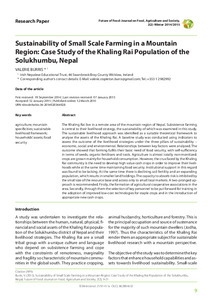| dc.date.accessioned | 2015-03-19T09:50:55Z | |
| dc.date.available | 2015-03-19T09:50:55Z | |
| dc.date.issued | 2015-03-12 | |
| dc.identifier.issn | 2197-411X | |
| dc.identifier.uri | urn:nbn:de:hebis:34-2014020344928 | |
| dc.identifier.uri | http://hdl.handle.net/123456789/2014020344928 | |
| dc.language.iso | eng | |
| dc.publisher | Department of Organic Food Quality and Food Culture at the University of Kassel, Germany and Federation of German Scientists (VDW) | eng |
| dc.rights | Urheberrechtlich geschützt | |
| dc.rights.uri | https://rightsstatements.org/page/InC/1.0/ | |
| dc.subject | agriculture | eng |
| dc.subject | mountain specificities | eng |
| dc.subject | sustainable livelihood framework | eng |
| dc.subject | households' assets | eng |
| dc.subject | food security | eng |
| dc.subject.ddc | 630 | |
| dc.title | Sustainability of Small Scale Farming in a Mountain Region: Case Study of the Khaling Rai Population of the Solukhumbu, Nepal | eng |
| dc.type | Aufsatz | |
| dcterms.abstract | The Khaling Rai live in a remote area of the mountain region of Nepal. Subsistence farming is central to their livelihood strategy, the sustainability of which was examined in this study. The sustainable livelihood approach was identified as a suitable theoretical framework to analyse the assets of the Khaling Rai. A baseline study was conducted using indicators to assess the outcome of the livelihood strategies under the three pillars of sustainability – economic, social and environmental. Relationships between key factors were analysed. The outcome showed that farming fulfils their basic need of food security, with self-sufficiency in terms of seeds, organic fertilisers and tools. Agriculture is almost totally non-monitized: crops are grown mainly for household consumption. However, the crux faced by the Khaling Rai community is the need to develop high value cash crops in order to improve their livelihoods while at the same time maintaining food security. Institutional support in this regard was found to be lacking. At the same time there is declining soil fertility and an expanding population, which results in smaller land holdings. The capacity to absorb risk is inhibited by the small size of the resource base and access only to small local markets. A two-pronged approach is recommended. Firstly, the formation of agricultural cooperative associations in the area. Secondly, through them the selection of key personnel to be put forward for training in the adoption of improved low-cost technologies for staple crops and in the introduction of appropriate new cash crops. | eng |
| dcterms.accessRights | open access | |
| dcterms.bibliographicCitation | In: Future of Food: Journal on Food, Agriculture and Society. Witzenhausen : University of Kassel, Department of Organic Food Quality and Food Culture. - Vol. 2, No. 2 (2014), S. 9-21 | |
| dcterms.creator | Burris, Valerie Mary | |

